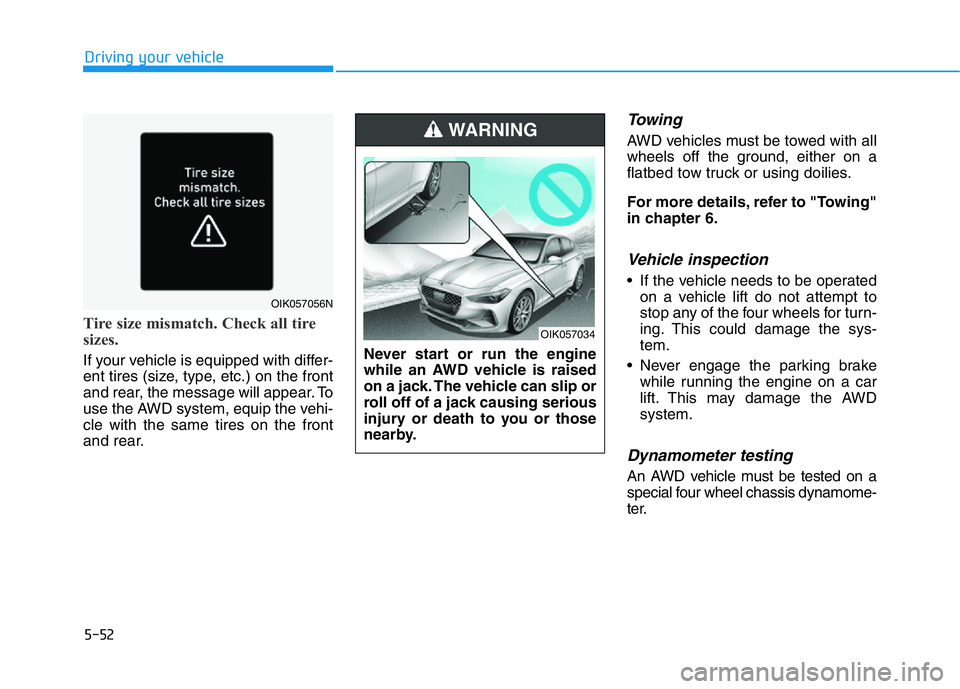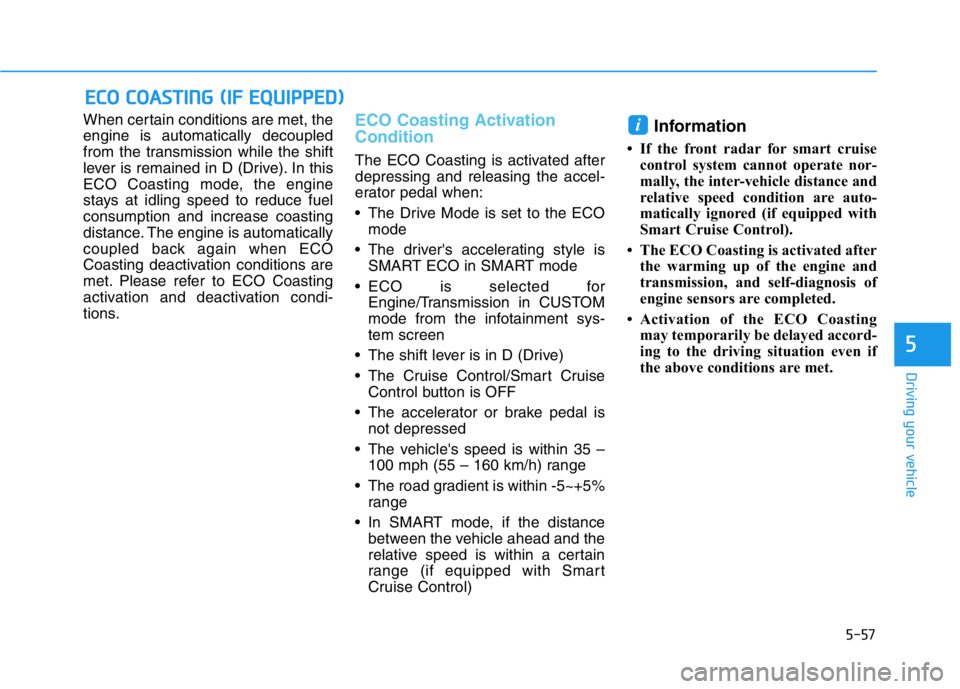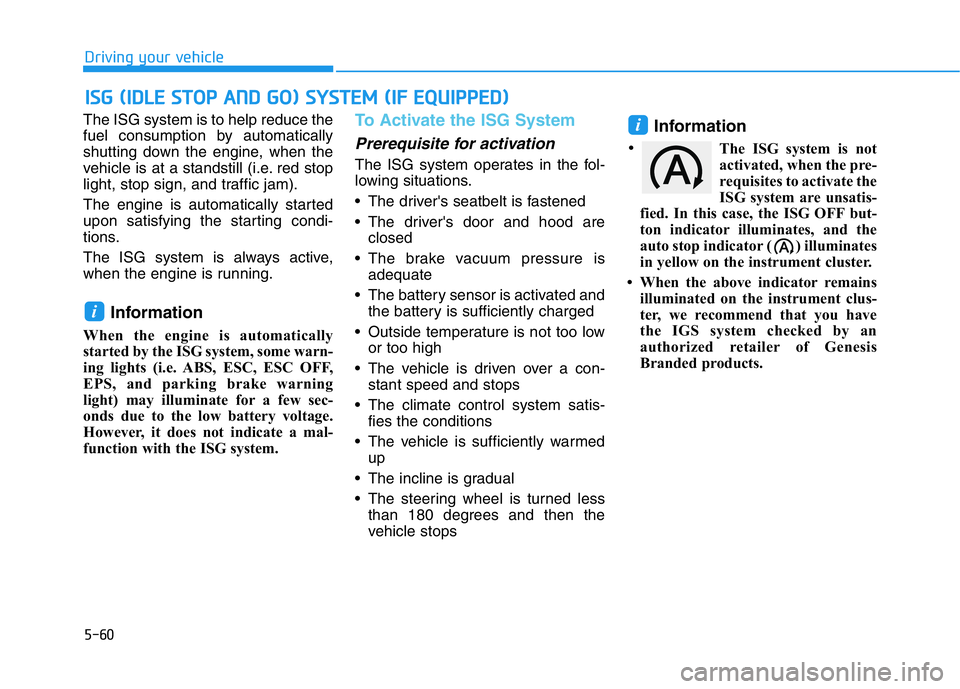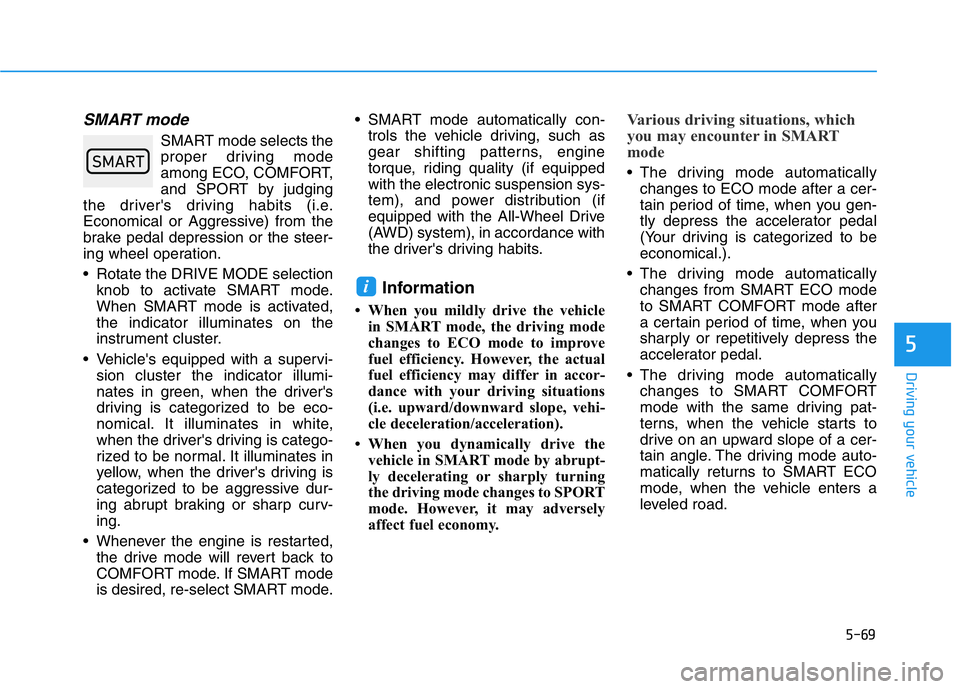brake GENESIS G70 2021 Repair Manual
[x] Cancel search | Manufacturer: GENESIS, Model Year: 2021, Model line: G70, Model: GENESIS G70 2021Pages: 516, PDF Size: 12.84 MB
Page 299 of 516

5-50
Driving your vehicle
Information
• Do not drive in water if the level is
higher than the bottom of the vehi-
cle.
• Check your brake condition once
you are out of mud or water.
Depress the brake pedal several
times as you move slowly until you
feel normal braking return.
• Shorten your scheduled mainte-
nance interval if you drive in off-
road conditions such as sand, mud
or water (see "Maintenance Under
Severe Usage Conditions" in chap-
ter 7).
• Make sure that an AWD vehicle is
towed by flatbed tow truck.
For safe AWD operation
Before driving
• Make sure all passengers are
wearing seat belts.
• Sit upright and adjust the steering
wheel to a position comfortable for
you to drive.
Driving on snow-covered or icy
roads
• Start off slowly by applying the
accelerator pedal gently.
• Use of snow tires is recommended.
For more information on Snow
Tires refer to "Winter Driving" in
this chapter.
• Keep sufficient distance between
your vehicle and the vehicle in front
of you.
• When approaching a stop sign or
stop light, release the accelerator
pedal to provide engine braking
during deceleration.
• Avoid speeding, rapid acceleration,
sudden brake applications, and
sharp turns to prevent skids.
Driving in sand or mud
• Maintain slow and constant speed.
• Keep sufficient distance between
your vehicle and the vehicle in front
of you.
• Reduce vehicle speed and always
check the road condition.
• Avoid speeding, rapid acceleration,
sudden brake applications, and
sharp turns to prevent getting
stuck.
When the vehicle is stuck in snow,
sand or mud, avoid running the
engine continuously at high rpm,
doing so may damage the tires,
transmission, differential or AWD
system.
NOTICE
i
Page 301 of 516

5-52
Driving your vehicle
Tire size mismatch. Check all tire
sizes.
If your vehicle is equipped with differ-
ent tires (size, type, etc.) on the front
and rear, the message will appear. To
use the AWD system, equip the vehi-
cle with the same tires on the front
and rear.
Towing
AWD vehicles must be towed with all
wheels off the ground, either on a
flatbed tow truck or using doilies.
For more details, refer to "Towing"
in chapter 6.
Vehicle inspection
• If the vehicle needs to be operated
on a vehicle lift do not attempt to
stop any of the four wheels for turn-
ing. This could damage the sys-
tem.
• Never engage the parking brake
while running the engine on a car
lift. This may damage the AWD
system.
Dynamometer testing
An AWD vehicle must be tested on a
special four wheel chassis dynamome-
ter. Never start or run the engine
while an AWD vehicle is raised
on a jack. The vehicle can slip or
roll off of a jack causing serious
injury or death to you or those
nearby.
WARNING
OIK057056N
OIK057034
Page 302 of 516

5-53
Driving your vehicle
5
An AWD vehicle should not be tested
on a 2WD roll tester. If a 2WD roll
tester must be used, perform the fol-
lowing procedure:
1. Check the tire pressures recom-
mended for your vehicle.
2. Place the rear wheels on the roll
tester for a speedometer test as
shown in the illustration.
3. Release the parking brake.
4. Place the front wheels on the tem-
porary free roller as shown in the
illustration.Limited Slip Differential refers to a
feature equipped with a mechanism
that controls the differential functions
of the wheels in the rear differential.
The Limited Slip Differential helps
improve handling performance when
circling at high speed. Keep away from the front of the
vehicle while the vehicle is in
gear on the dynamometer. The
vehicle can jump forward and
cause serious injury or death.
WARNING
OIK057035
Roll Tester (Speedometer)
Temporary Free Roller
LIMITED SLIP DIFFERENTIAL
(IF EQUIPPED)
Never run wheels with one of
them lifted by the jack. It is
extremely dangerous for a vehi-
cle equipped with Limited Slip
Differential.
WARNING
Page 304 of 516

5-55
Driving your vehicle
5
The Launch Control system controls
the vehicle to reduce wheel spin or
slip on a hard acceleration from a
standing start.
Prerequisite for Activation
The Launch Control gets ready to be
activated, when the following prereq-
uisites are satisfied.
• The engine is warmed up.
• Malfunction warning lights related
to the engine and ESC (Electronic
Stability Control) are off.
Launch Control Activation
To activate Launch Control:
1. Select SPORT mode using the
drive mode selection knob.
SPORT indicator will illuminate on
the instrument cluster LCD dis-
play.
2. Turn off ESC by pressing the ESC
OFF button for more than 3 sec-
onds. The ESC OFF indicator will
illuminate on the instrument clus-
ter.
3. Shift to the D (Drive) position.4. Depress the brake pedal firmly
with your left foot, while depress-
ing the accelerator pedal down
fully with your right foot. Then, the
Engine rpm will reach an opti-
mized level.
The message "Launch Control
Ready" will appear in the instru-
ment cluster LCD display.
5. A smooth, quick release of the
brake pedal, while maintaining full
depression of the accelerator
pedal will initiate launching of the
vehicle.
LAUNCH CONTROL (IF EQUIPPED)
OIK057072L
For safety purposes, check the
following conditions before
using Launch control.
•The driver's seat belt is fas-
tened.
•All doors, hood and trunk is
closed.
•The vehicle is at a complete
stop.
•Align the steering wheel
straight.
CAUTION
Page 306 of 516

5-57
Driving your vehicle
5
When certain conditions are met, the
engine is automatically decoupled
from the transmission while the shift
lever is remained in D (Drive). In this
ECO Coasting mode, the engine
stays at idling speed to reduce fuel
consumption and increase coasting
distance. The engine is automatically
coupled back again when ECO
Coasting deactivation conditions are
met. Please refer to ECO Coasting
activation and deactivation condi-
tions.ECO Coasting Activation
Condition
The ECO Coasting is activated after
depressing and releasing the accel-
erator pedal when:
• The Drive Mode is set to the ECO
mode
• The driver's accelerating style is
SMART ECO in SMART mode
• ECO is selected for
Engine/Transmission in CUSTOM
mode from the infotainment sys-
tem screen
• The shift lever is in D (Drive)
• The Cruise Control/Smart Cruise
Control button is OFF
• The accelerator or brake pedal is
not depressed
• The vehicle's speed is within 35 –
100 mph (55 – 160 km/h) range
• The road gradient is within -5~+5%
range
• In SMART mode, if the distance
between the vehicle ahead and the
relative speed is within a certain
range (if equipped with Smart
Cruise Control)
Information
• If the front radar for smart cruise
control system cannot operate nor-
mally, the inter-vehicle distance and
relative speed condition are auto-
matically ignored (if equipped with
Smart Cruise Control).
• The ECO Coasting is activated after
the warming up of the engine and
transmission, and self-diagnosis of
engine sensors are completed.
• Activation of the ECO Coasting
may temporarily be delayed accord-
ing to the driving situation even if
the above conditions are met.
i
ECO COASTING (IF EQUIPPED)
Page 309 of 516

5-60
Driving your vehicle
The ISG system is to help reduce the
fuel consumption by automatically
shutting down the engine, when the
vehicle is at a standstill (i.e. red stop
light, stop sign, and traffic jam).
The engine is automatically started
upon satisfying the starting condi-
tions.
The ISG system is always active,
when the engine is running.
Information
When the engine is automatically
started by the ISG system, some warn-
ing lights (i.e. ABS, ESC, ESC OFF,
EPS, and parking brake warning
light) may illuminate for a few sec-
onds due to the low battery voltage.
However, it does not indicate a mal-
function with the ISG system.
To Activate the ISG System
Prerequisite for activation
The ISG system operates in the fol-
lowing situations.
• The driver's seatbelt is fastened
• The driver's door and hood are
closed
• The brake vacuum pressure is
adequate
• The battery sensor is activated and
the battery is sufficiently charged
• Outside temperature is not too low
or too high
• The vehicle is driven over a con-
stant speed and stops
• The climate control system satis-
fies the conditions
• The vehicle is sufficiently warmed
up
• The incline is gradual
• The steering wheel is turned less
than 180 degrees and then the
vehicle stops
Information
The ISG system is not
activated, when the pre-
requisites to activate the
ISG system are unsatis-
fied. In this case, the ISG OFF but-
ton indicator illuminates, and the
auto stop indicator ( ) illuminates
in yellow on the instrument cluster.
• When the above indicator remains
illuminated on the instrument clus-
ter, we recommend that you have
the IGS system checked by an
authorized retailer of Genesis
Branded products.
i
i
ISG (IDLE STOP AND GO) SYSTEM (IF EQUIPPED)
•
Page 310 of 516

5-61
Driving your vehicle
5
Auto stop
To stop the engine in idle stop mode
1. Decrease the vehicle speed to 0
km/h.
2. Depress the brake pedal with the
shift lever in D (Drive) or N
(Neutral).
The auto stop indicator ( ) illumi-
nates in green on the instrument
cluster, when the engine stops.
Information
The driving speed must reach at least
5 mph (8 km/h) after an idle stop to
stop the engine in idle stop mode
again.In auto stop mode, when the driver
opens the hood, the ISG system will
be deactivated.
When the system is deactivated:
The ISG OFF button indicator illumi-
nates.The message, "Auto Stop is Off!.
Start vehicle manually", appears on
the LCD display with a beep sound.
At this time, restart the vehicle man-
ually by depressing the brake pedal
with the vehicle shifted to P (Park) or
N (Neutral). But for your safety,
restart the vehicle in the P (Park)
position.
i
OIK057018N
OIK057019N
OIK057173N
Page 311 of 516

5-62
Driving your vehicle
Auto start
To restart the engine in the auto
stop mode
• Release the brake pedal.
- When Auto Hold (if equipped with
EPB (Electronic Parking Brake))
is activated, if you release the
brake pedal, the engine will be in
the auto stop state. However, if
you depress the accelerator
pedal, the engine will start again.
The auto stop indicator ( ) goes
OFF on the instrument cluster, when
the engine is restarted.
The engine is automatically restart-
ed in the following situations.
• The brake vacuum pressure is low
• The engine has stopped for about
5 minutes
• The air conditioning is ON with the
fan speed set to the highest posi-
tion
• The front defroster is ON
• The battery is weak
• The cooling and heating perform-
ance of the climate control system
is unsatisfactory
• The vehicle is shifted to P (Park)
when Auto Hold is activated
• The door is opened or the seatbelt
is unfastened when Auto Hold is
activated
• The EPB switch is pressed when
Auto Hold is activated
The auto stop indicator ( ) blinks
in green for 5 seconds on the instru-
ment cluster.
The auto start is temporarily deac-
tivated in the following situations.
• When the shift lever is shifted from
N (Neutral) to R (Reverse), D
(Drive) or Manual shift mode with-
out the brake pedal depressed. A
message "Press brake pedal for
Auto Start" will appear on the LCD
display. To activate auto start,
depress the brake pedal.
OIK057086N
Page 313 of 516

5-64
Driving your vehicle
The Battery Sensor
Deactivation
The battery sensor is deactivated,
when the battery is disconnected
from the negative pole for mainte-
nance purpose.
In this case, the ISG system is limit-
edly operated due to the battery sen-
sor deactivation. Thus, the driver
needs to take the following proce-
dures to reactivate the battery sen-
sor after disconnecting the battery.
Prerequisites to reactivate the
battery sensor
Keep the engine in the OFF status
for 4 hours, and attempt to restart the
engine 3 to 4 times for the battery-
sensor reactivation.
Pay extreme caution not to connect
any accessories (i.e. navigation and
black box) to the vehicle with the
engine in the OFF status. If not, the
battery sensor may not be reactivat-
ed.
Information
The ISG system may not operate in
the following situations.
- There is a malfunction with the ISG
system.
- The battery is weak.
- The brake vacuum pressure is low.
If this occurs, have the ISG system
checked by an authorized retailer of
Genesis Branded products.• Use only Genesis/Hyundai ISG
battery for replacement. If not,
the ISG system may not normal-
ly operate.
• Do not recharge the ISG battery
with a general battery charger. It
may damage or explode the ISG
battery.
• Do not remove the battery cap.
The battery electrolyte, which is
harmful to the human body, may
leak out.
NOTICE
iOIK057041
Battery sensor
Page 318 of 516

5-69
Driving your vehicle
5
SMART mode
SMART mode selects the
proper driving mode
among ECO, COMFORT,
and SPORT by judging
the driver's driving habits (i.e.
Economical or Aggressive) from the
brake pedal depression or the steer-
ing wheel operation.
• Rotate the DRIVE MODE selection
knob to activate SMART mode.
When SMART mode is activated,
the indicator illuminates on the
instrument cluster.
• Vehicle's equipped with a supervi-
sion cluster the indicator illumi-
nates in green, when the driver's
driving is categorized to be eco-
nomical. It illuminates in white,
when the driver's driving is catego-
rized to be normal. It illuminates in
yellow, when the driver's driving is
categorized to be aggressive dur-
ing abrupt braking or sharp curv-
ing.
• Whenever the engine is restarted,
the drive mode will revert back to
COMFORT mode. If SMART mode
is desired, re-select SMART mode.• SMART mode automatically con-
trols the vehicle driving, such as
gear shifting patterns, engine
torque, riding quality (if equipped
with the electronic suspension sys-
tem), and power distribution (if
equipped with the All-Wheel Drive
(AWD) system), in accordance with
the driver's driving habits.
Information
• When you mildly drive the vehicle
in SMART mode, the driving mode
changes to ECO mode to improve
fuel efficiency. However, the actual
fuel efficiency may differ in accor-
dance with your driving situations
(i.e. upward/downward slope, vehi-
cle deceleration/acceleration).
• When you dynamically drive the
vehicle in SMART mode by abrupt-
ly decelerating or sharply turning
the driving mode changes to SPORT
mode. However, it may adversely
affect fuel economy.
Various driving situations, which
you may encounter in SMART
mode
• The driving mode automatically
changes to ECO mode after a cer-
tain period of time, when you gen-
tly depress the accelerator pedal
(Your driving is categorized to be
economical.).
• The driving mode automatically
changes from SMART ECO mode
to SMART COMFORT mode after
a certain period of time, when you
sharply or repetitively depress the
accelerator pedal.
• The driving mode automatically
changes to SMART COMFORT
mode with the same driving pat-
terns, when the vehicle starts to
drive on an upward slope of a cer-
tain angle. The driving mode auto-
matically returns to SMART ECO
mode, when the vehicle enters a
leveled road.
i
�6�0�$�5�7